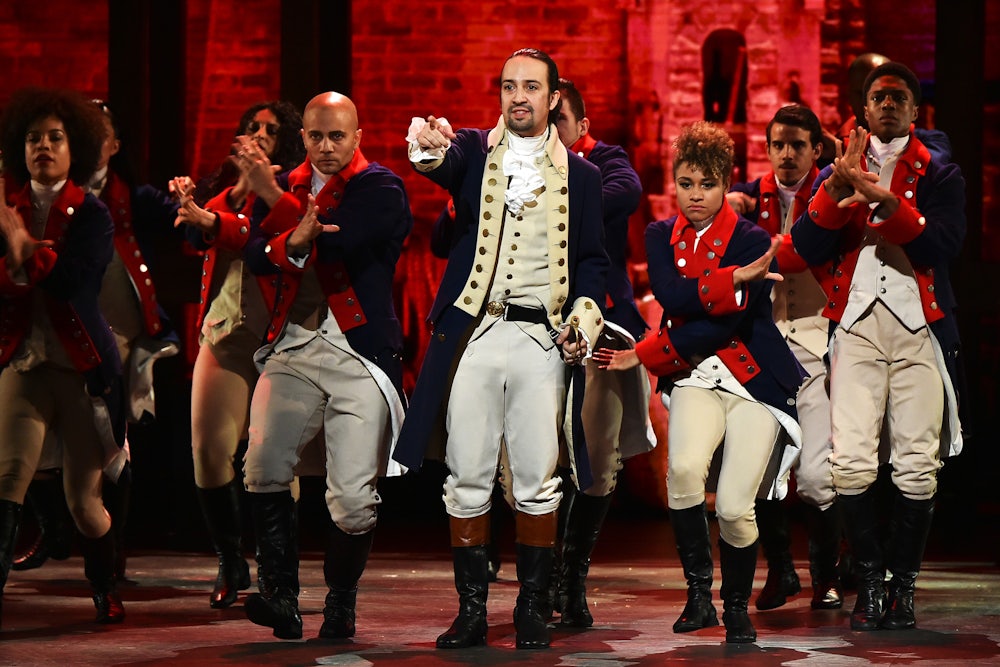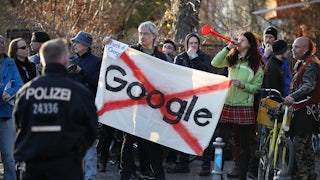As a lifelong fan of musical theater, it gives me no pleasure to admit that it’s an art form with often iffy ideological undercurrents—a landscape surely made worse by its fanbase: A 2019 report found that Broadway audiences are 74 percent white and boast average household incomes of $260,000 per year. So anytime genuinely left-of-center lyrics manage to creep into the libretto of a smash hit, it can be downright exhilarating. This is perhaps doubly true when they crop up in a film adaptation, and it’s one of your first chances to imagine being back in a theater after 15 months of a pandemic that forced America’s best theater artists off the boards.
In the Heights is the long-awaited screen version of the show that Lin Manuel Miranda began writing in college and which made its regional theater debut in 2005, a decade before he became a household name with Hamilton. It’s a spot-on summer movie, set in the heavily Dominican Washington Heights neighborhood of Upper Manhattan, that tells interwoven stories of how gentrification threatens to unravel the low- and middle-income community already living there.
At first blush, the show has much in common with Miranda’s iconic follow-up, Hamilton, which famously retools the most bedrock of American founding myths. Beyond having innovative musical scores inspired by rap and hip-hop, both shows are ostensibly progressive texts that feature people of color in nearly every role and relay narratives from their perspectives, thereby challenging a historical status quo that often shoves them to the side. But while In the Heights sheds light on the class structures oppressing its heroes, Hamilton at best obfuscates its protagonist’s role in constructing them centuries before. If Miranda’s artistic prowess undeniably matured between the two musicals, the political analyses underpinning them devolved into contradiction: In many ways, Alexander Hamilton is the villain of In the Heights.
The urban political processes explored by In the Heights have only accelerated since the show first graced the stage in the mid-2000s. As outlined in a 2018 policy brief from the Center for Dominican Studies at the City University of New York, the cost of housing in the Washington Heights and Inwood neighborhoods increased sixfold from 1999 to 2014. In 2014, the average white resident’s income was more than 2.5 times larger than the average Dominican income, and white residents were less likely to be rent-burdened and more likely to own their own homes. As Samuel Stein describes in his book Capital City, real estate capital is worth over $200 trillion worldwide, comprising some 60 percent of all wealth on earth. Moreover, large influxes of speculative capital have fueled gentrification in New York and cities across the world: Between 2013 and 2019, developers bought up over $600 million in property across Inwood, which shares a border with Washington Heights.
In the Heights’s take on this dynamic would feel at home in the Bernie Sanders campaign. Around midway through the show, the audience is treated to a synchronized full-company song and dance number shot in a public pool. The mostly Latino characters congregating there have learned that a winning lottery ticket worth $96,000 was just sold at the bodega where cousins Usnavi and Sonny both work. That number, and the rare opportunity for escape it offers, dazzles residents of a neighborhood increasingly used to seeing its neighbors priced out—a previous scene takes place in a long-standing hair salon that has been forced to shut down and reopen in the Bronx by its landlord’s relentless rent hikes. The local poolgoers fantasize about what they’d do with the lottery bundle: One confides that she’d pick up and start over in Atlantic City; another daydreams about schmoozing with Tiger Woods, a reference understandably changed from “Donald Trump” in the original stage production! A teenage Sonny envisions a potential avenue for systemic change that amounts to a thesis for the show writ large:
Yo with ninety-six thousand I’d finally fix housin’/
Give the barrio computers with wireless web browsin’/
Your kids are livin’ without a good edjumacation/
Change the station, teach ’em about gentrification
The rent is escalatin’/The rich are penetratin’/We pay our corporations when we should be demonstratin’
What about immigration? Politicians be hatin’/Racism in this nation gone from latent to blatant
I’ll cash my ticket and picket, invest in protest
Never lose my focus ’til the city takes notice.
If you can stomach the corniness (and with musicals, that’s part of the deal!), Sonny not only rightfully connects inadequate housing, lagging investments in public education, and racism, but he also points to class struggle as the way to fight back—pointing his finger at “the rich” and “corporations” and calling for direct action in the form of protest. (While the movie stops short of portraying, say, civil disobedience or militant labor actions, Sonny does mobilize friends to an immigrant rights protest, where he reveals that he is undocumented.) His outrage at community members’ lack of control over their own lives could be seen as a call for the sort of democracy about which Alexander Hamilton never particularly cared.
Despite his transformation into a progressive visionary, courtesy of the Broadway megahit bearing his name, Hamilton is more accurately associated with the interests of capital than those of ordinary Americans. While the show celebrates the first treasury secretary for ushering in the American financial system, it glosses over the fact that Hamilton’s vision privileged the monied classes from the get-go.
As most soldiers during the Revolutionary War were paid in IOUs, merchants and other speculators had been buying them up on the cheap from men who couldn’t afford to wait until full repayment—sparking eventual fights among the Founding Fathers about whether to pay actual soldiers or those rich enough to exploit them. Not only did Hamilton side with the merchants, he went on to back a regressive whiskey tax instead of a progressive one that might hurt their bottom lines. When the move eventually sparked a rebellion in 1794, Hamilton wanted to send armed troops to Pennsylvania to squash it.
In other words, Hamilton’s alignment with the bigwigs pitted him against the historical antecedents of Usnavi, Sonny, and their neighbors in Washington Heights. As one Boston Review essay explicitly noted, Hamilton’s taxation philosophy prioritized business interests, including Eastern real estate speculators—albeit before they could have ever hoped to claim $2,000 a month for a one-bedroom in Upper Manhattan. And while one could plausibly picture the theatrical Hamilton sharing some sense of immigrant solidarity with the characters Miranda situates in the barrio, the real-life analog backed 1798’s Alien and Sedition Acts, which made it harder to become a U.S. citizen and easier to deport those who weren’t. (That the laws also criminalized criticizing the federal government would have precluded an eighteenth-century version of Sonny from protesting the law’s autocratic overreach.)
If Hamilton isn’t meant to be understood as strictly historically accurate, it’s nevertheless difficult to dispute the idea that the musical explicitly embraces fundamental American ideas and Hamilton’s role in engineering them—even if those ideas did include slavery (the abolition thereof Hamilton never actually campaigned for) and the business interests that institution so brutally upheld. Centuries later, enslaved people’s descendants—both African Americans and Afro-Latinos—would find themselves still stripped of generational wealth through redlining, Jim Crow, and imperialism. These forces eventually drove them and others to neighborhoods like Washington Heights—offering the heirs of Hamilton’s favored class yet another business opportunity, and leaving the underclass that’s lionized by In The Heights once again at the mercy of those who stand to profit off them.








